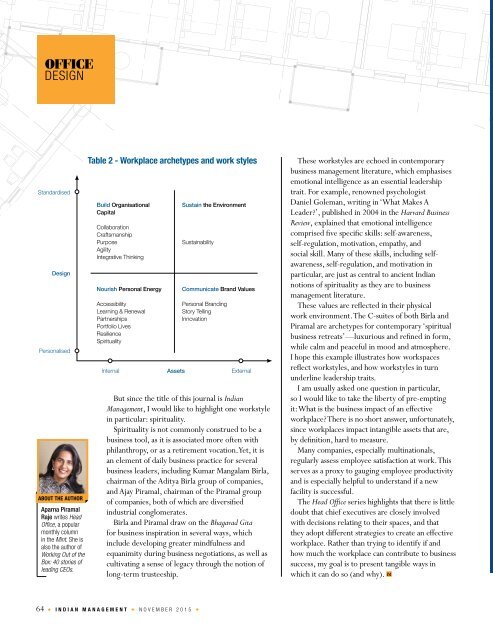the new hr
1NT8tPl
1NT8tPl
You also want an ePaper? Increase the reach of your titles
YUMPU automatically turns print PDFs into web optimized ePapers that Google loves.
office<br />
design<br />
Standardised<br />
Design<br />
Personalised<br />
ABOUT THE AUTHOR<br />
Aparna Piramal<br />
Raje writes Head<br />
Office, a popular<br />
monthly column<br />
in <strong>the</strong> Mint. She is<br />
also <strong>the</strong> author of<br />
Working Out of <strong>the</strong><br />
Box: 40 stories of<br />
leading CEOs.<br />
Table 2 - Workplace archetypes and work styles<br />
Build Organisational<br />
Capital<br />
Collaboration<br />
Craftsmanship<br />
Purpose<br />
Agility<br />
Integrative Thinking<br />
Nourish Personal Energy<br />
Accessibility<br />
Learning & Re<strong>new</strong>al<br />
Partnerships<br />
Portfolio Lives<br />
Resilience<br />
Spirituality<br />
Sustain <strong>the</strong> Environment<br />
Sustainability<br />
Communicate Brand Values<br />
Personal Branding<br />
Story Telling<br />
Innovation<br />
Internal Assets External<br />
But since <strong>the</strong> title of this journal is Indian<br />
Management, I would like to highlight one workstyle<br />
in particular: spirituality.<br />
Spirituality is not commonly construed to be a<br />
business tool, as it is associated more often with<br />
philant<strong>hr</strong>opy, or as a retirement vocation. Yet, it is<br />
an element of daily business practice for several<br />
business leaders, including Kumar Mangalam Birla,<br />
chairman of <strong>the</strong> Aditya Birla group of companies,<br />
and Ajay Piramal, chairman of <strong>the</strong> Piramal group<br />
of companies, both of which are diversified<br />
industrial conglomerates.<br />
Birla and Piramal draw on <strong>the</strong> Bhagavad Gita<br />
for business inspiration in several ways, which<br />
include developing greater mindfulness and<br />
equanimity during business negotiations, as well as<br />
cultivating a sense of legacy t<strong>hr</strong>ough <strong>the</strong> notion of<br />
long-term trusteeship.<br />
These workstyles are echoed in contemporary<br />
business management literature, which emphasises<br />
emotional intelligence as an essential leadership<br />
trait. For example, renowned psychologist<br />
Daniel Goleman, writing in ‘What Makes A<br />
Leader?’, published in 2004 in <strong>the</strong> Harvard Business<br />
Review, explained that emotional intelligence<br />
comprised five specific skills: self-awareness,<br />
self-regulation, motivation, empathy, and<br />
social skill. Many of <strong>the</strong>se skills, including selfawareness,<br />
self-regulation, and motivation in<br />
particular, are just as central to ancient Indian<br />
notions of spirituality as <strong>the</strong>y are to business<br />
management literature.<br />
These values are reflected in <strong>the</strong>ir physical<br />
work environment. The C-suites of both Birla and<br />
Piramal are archetypes for contemporary ‘spiritual<br />
business retreats’—luxurious and refined in form,<br />
while calm and peaceful in mood and atmosphere.<br />
I hope this example illustrates how workspaces<br />
reflect workstyles, and how workstyles in turn<br />
underline leadership traits.<br />
I am usually asked one question in particular,<br />
so I would like to take <strong>the</strong> liberty of pre-empting<br />
it: What is <strong>the</strong> business impact of an effective<br />
workplace? There is no short answer, unfortunately,<br />
since workplaces impact intangible assets that are,<br />
by definition, hard to measure.<br />
Many companies, especially multinationals,<br />
regularly assess employee satisfaction at work. This<br />
serves as a proxy to gauging employee productivity<br />
and is especially helpful to understand if a <strong>new</strong><br />
facility is successful.<br />
The Head Office series highlights that <strong>the</strong>re is little<br />
doubt that chief executives are closely involved<br />
with decisions relating to <strong>the</strong>ir spaces, and that<br />
<strong>the</strong>y adopt different strategies to create an effective<br />
workplace. Ra<strong>the</strong>r than trying to identify if and<br />
how much <strong>the</strong> workplace can contribute to business<br />
success, my goal is to present tangible ways in<br />
which it can do so (and why).<br />
64 INDIAN MANAGEMENT NOVEMBER 2015


